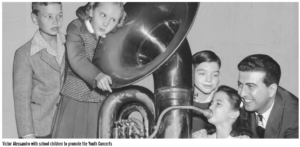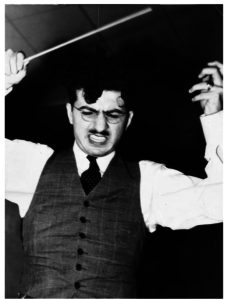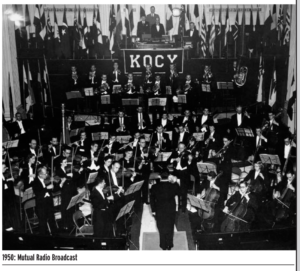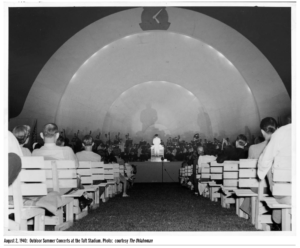Re-Organized and Re-Invigorated
 By the time the 1945-1946 Season started the board had rescinded the “liquidation” and had not only raised the necessary funds to run the orchestra for the year; they raised enough to retire a significant part of the debt accumulated since the end of the New Deal federal support that built the orchestra from 1937 to 1943. Newly appointed as manager, Joe Federhan was in place and Symphony board president, Dr. Waldo Stephens announced that the “Save Our Symphony” campaign brought in contributions statewide from 17 cities and concerts would be played in six cities around Oklahoma.
By the time the 1945-1946 Season started the board had rescinded the “liquidation” and had not only raised the necessary funds to run the orchestra for the year; they raised enough to retire a significant part of the debt accumulated since the end of the New Deal federal support that built the orchestra from 1937 to 1943. Newly appointed as manager, Joe Federhan was in place and Symphony board president, Dr. Waldo Stephens announced that the “Save Our Symphony” campaign brought in contributions statewide from 17 cities and concerts would be played in six cities around Oklahoma.
Brought in to advise the new organization, Arthur Judson, manager of the New York Philharmonic Symphony Orchestra, encouraged the influential orchestra patron Mrs. E. Gordon Ferguson to start a women’s committee (today’s OKC Orchestra League). He purposed the group with educating the community about the benefits of the orchestra and the continuing need for financial support. The Women’s Committee was organized in October 1948, dues were set at two dollars per year and twenty-five members were signed up for the first year.
Victor Alessandro, Jr. – A Rising Star :: Music Director 1938 – 1951
 Newly re-named, The Oklahoma State Symphony Orchestra was operating with an annual budget of $120,000 by 1947 and working effectively in both fundraising and music-making. The young conductor Victor Alessandro, Jr., was acclaimed for his musicianship and his abilities as an orchestra builder. Alessandro was the youngest conductor of a major orchestra in the United States at just 22 years old when he was contracted in 1938. Throughout the years of World War II, his connections with his mentor at the Eastman School of Music in Rochester, New York, famed composer Howard Hanson, proved extremely valuable. Alessandro’s orchestra was continuously in flux with musicians leaving for and returning from their war duties. Young players from Eastman came to play in Oklahoma City and their talents helped Alessandro maintain the quality of the orchestra. After surviving the near “liquidation” of the 1945-1946 Season, Alessandro was eager to have his orchestra heard.
Newly re-named, The Oklahoma State Symphony Orchestra was operating with an annual budget of $120,000 by 1947 and working effectively in both fundraising and music-making. The young conductor Victor Alessandro, Jr., was acclaimed for his musicianship and his abilities as an orchestra builder. Alessandro was the youngest conductor of a major orchestra in the United States at just 22 years old when he was contracted in 1938. Throughout the years of World War II, his connections with his mentor at the Eastman School of Music in Rochester, New York, famed composer Howard Hanson, proved extremely valuable. Alessandro’s orchestra was continuously in flux with musicians leaving for and returning from their war duties. Young players from Eastman came to play in Oklahoma City and their talents helped Alessandro maintain the quality of the orchestra. After surviving the near “liquidation” of the 1945-1946 Season, Alessandro was eager to have his orchestra heard.
The Oklahoma State Symphony Orchestra performed successful local performances for large and appreciative audiences and was occasionally broadcasting concerts locally on WKY radio starting in 1941. In the mid-1940s the Symphony was approached by the National Broadcast Corporation (NBC) to perform with Lucille Manners, a popular radio star. Her public demanded “in person” shows and she traveled the country performing with orchestras. The first national broadcast for the Oklahoma State Symphony Orchestra was with Ms. Manners in April 1944. This led to subsequent NBC concert broadcasts on the program “Orchestras of the Nation” from 1948 to 1949.
Victor Alessandro was known for his exacting standards of performance and demands for top quality playing, but his many practical jokes were often the glue that held the orchestra together in the days of 6 and 8 hour rehearsals. It’s said that at one memorable concert, Alessandro raised his head after coughing to give a downbeat and was wearing an enormous set of wax teeth. The musicians struggled to maintain composure and performed the entire piece for an audience, which was completely unaware of the prank.
 In 1949 a remarkable opportunity came to the Symphony. The orchestra started broadcasts on radio stations throughout Oklahoma originating with station KOCY with broadcast recordings done at the rehearsal room of the Municipal Auditorium (previous name of the Civic Center Music Hall). After only a few of these regional broadcasts, starting in January 1950, an international broadcast series of concerts was arranged by the Oklahoma City Chamber of Commerce in conjunction with the Mutual Broadcast Network and its affiliate stations. Again re-christened as The Oklahoma City Symphony Orchestra, the ensemble was now on the air twice a month throughout the United States and carried around the world by the Armed Services Overseas network.
In 1949 a remarkable opportunity came to the Symphony. The orchestra started broadcasts on radio stations throughout Oklahoma originating with station KOCY with broadcast recordings done at the rehearsal room of the Municipal Auditorium (previous name of the Civic Center Music Hall). After only a few of these regional broadcasts, starting in January 1950, an international broadcast series of concerts was arranged by the Oklahoma City Chamber of Commerce in conjunction with the Mutual Broadcast Network and its affiliate stations. Again re-christened as The Oklahoma City Symphony Orchestra, the ensemble was now on the air twice a month throughout the United States and carried around the world by the Armed Services Overseas network.
Frank White, president of the Mutual Broadcasting System, came to Oklahoma City for the first of the programs which were performed and broadcast from the First Christian Church at N.W. 10th and Robinson Avenue. The first half-hour broadcast brought the comment from Councilman Earl Miller who said, “The good publicity this city will get from these symphony broadcasts will do much to offset Oklahoma City’s reputation of being a place where there are only cowboys, Indians and six-guns.”
In fact, letters poured into the city from all over the world from both the music elite and from people listening to the concerts over more than 700 radio stations. The opening broadcast program included music from Alban Berg’s opera Lulu and Paul Hindemith’s Overture to the opera News Of The Day. The program closed with Richard Rodgers and Oscar Hammerstein’s Oklahoma! Selections for the concerts were to include repertory composed after statehood was declared in Oklahoma so the broadcasts were centered on music written after 1907.
By the 1950-51 Season, the live radio broadcasts had expanded to one hour for each of the 26 concerts and were heard around the world as broadcast on Sunday evenings between nine and ten o’clock PM from the Oklahoma City University Auditorium. Later, Radio Free Europe was added to the network of broadcasters. In the end, the concert broadcasts were heard over the Mutual Broadcasting System, the Armed Forces Radio Service, theTrans-Canada Network of the Canadian Broadcasting System, the Voice of America, and Radio Free Europe.
 This excitement brought an offer from Allegro Recording Company for the 1950-1951 Season. Given this thrilling opportunity, civic leaders such as U.S. Senator Robert S. Kerr, city manager Stanley Draper and oil magnate Frank Buttram gathered a group of other important residents and collected pledges of $22,500 toward the $30,000 needed to fund the recording. A recording was made in December 1950, for the first time ever, of Claude Debussy’s Le Martyre de Saint Sebastien with orchestra, chorus and soloists; all 21 of the Hungarian Dances by Johannes Brahms; and Mozart’s piano concertos No. 17 and No. 19.
This excitement brought an offer from Allegro Recording Company for the 1950-1951 Season. Given this thrilling opportunity, civic leaders such as U.S. Senator Robert S. Kerr, city manager Stanley Draper and oil magnate Frank Buttram gathered a group of other important residents and collected pledges of $22,500 toward the $30,000 needed to fund the recording. A recording was made in December 1950, for the first time ever, of Claude Debussy’s Le Martyre de Saint Sebastien with orchestra, chorus and soloists; all 21 of the Hungarian Dances by Johannes Brahms; and Mozart’s piano concertos No. 17 and No. 19.
 With broadcasts, the recording and the largest per capita subscription base of any orchestra in the country, Victor Alessandro was getting significant national attention. In October, 1950, at age 35, he was nominated by the U.S. Junior Chamber of Commerce as one of the ten outstanding young men in the country. Reviews of the LP release were overwhelmingly complimentary, as were reviews of the radio broadcasts. A Chicago music critic urged the Chicago Symphony to strive to not only compare with the “Big 3” orchestras of New York, Boston and Philadelphia, but to be honest enough to recognize there could be inspirational musical activity in Oklahoma City as well. He went on to admire the programming selected by Alessandro that used, with equal design, folk themes, music based on literature, drama scores, musical theater and samplings of European and American classical music.
With broadcasts, the recording and the largest per capita subscription base of any orchestra in the country, Victor Alessandro was getting significant national attention. In October, 1950, at age 35, he was nominated by the U.S. Junior Chamber of Commerce as one of the ten outstanding young men in the country. Reviews of the LP release were overwhelmingly complimentary, as were reviews of the radio broadcasts. A Chicago music critic urged the Chicago Symphony to strive to not only compare with the “Big 3” orchestras of New York, Boston and Philadelphia, but to be honest enough to recognize there could be inspirational musical activity in Oklahoma City as well. He went on to admire the programming selected by Alessandro that used, with equal design, folk themes, music based on literature, drama scores, musical theater and samplings of European and American classical music.
At the height of this activity, Victor Alessandro decided to move on in his career and took the music director position of the San Antonio Symphony, announcing his resignation from the Oklahoma City Symphony Orchestra in January 1951. Oklahomans were sorry to see him leave. Music critic Tracy Silvester commented in the Daily Oklahoman, “In an area that has run pretty much to hillbilly and jukebox renditions, he has developed a literal orchestra [public] through sheer grit in presenting only what he thought was good music.”













